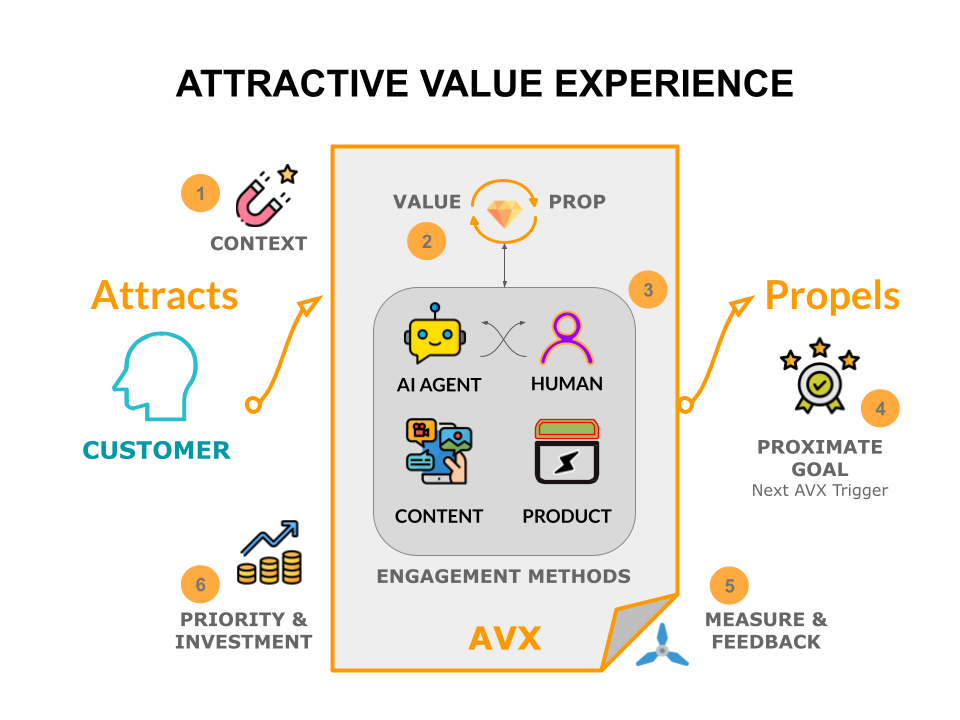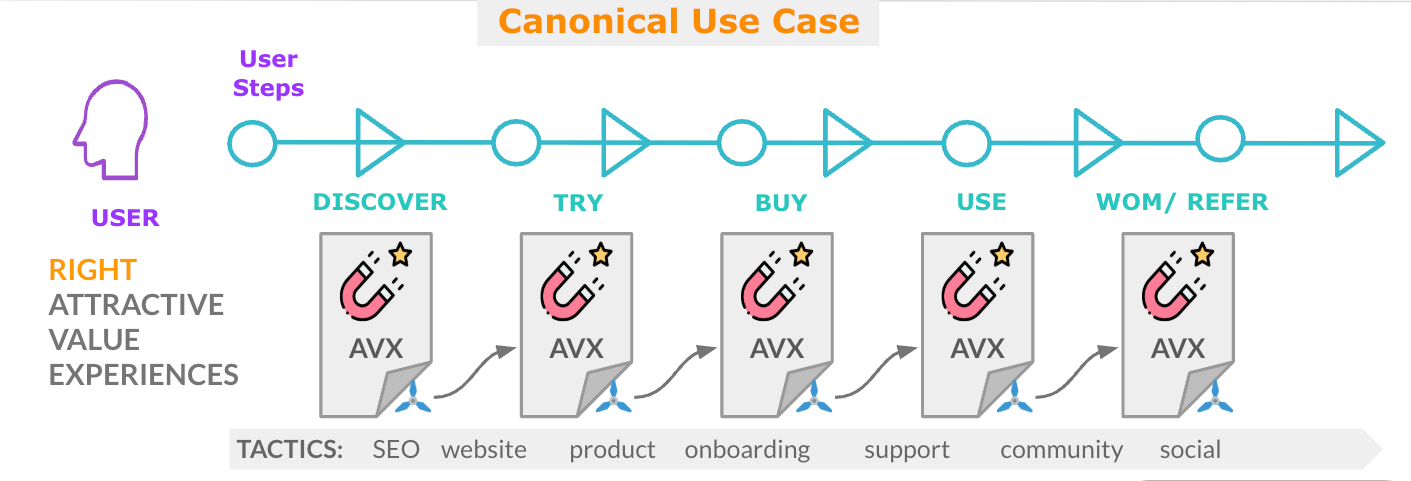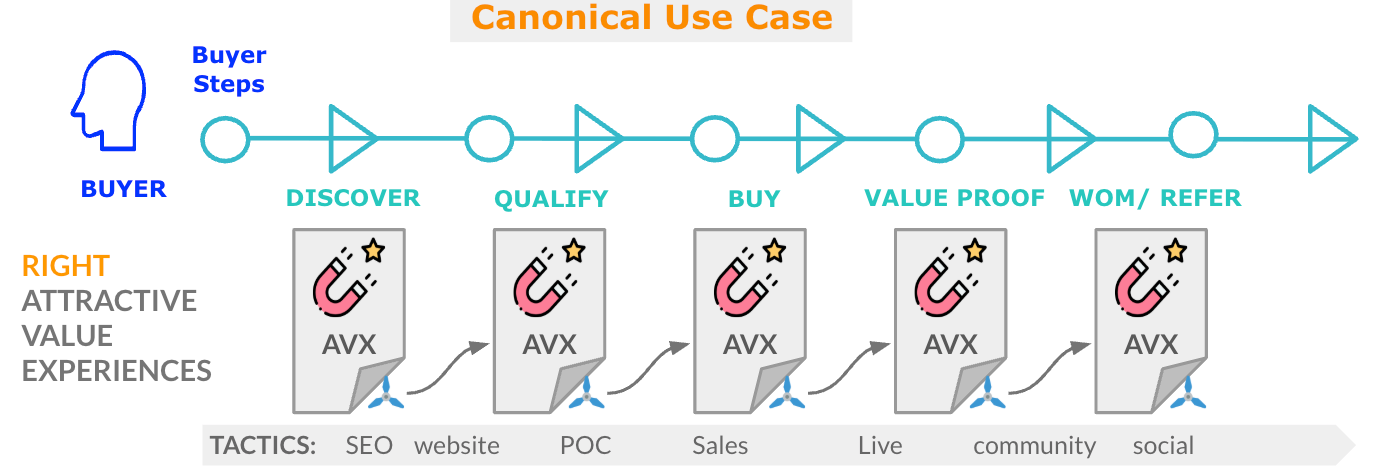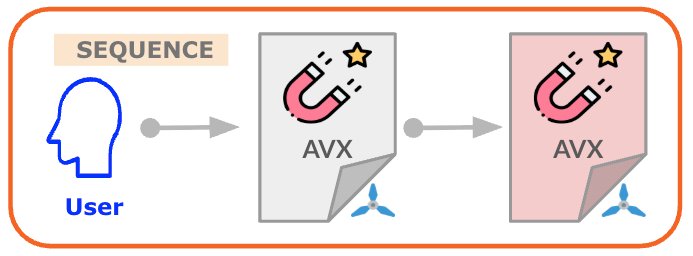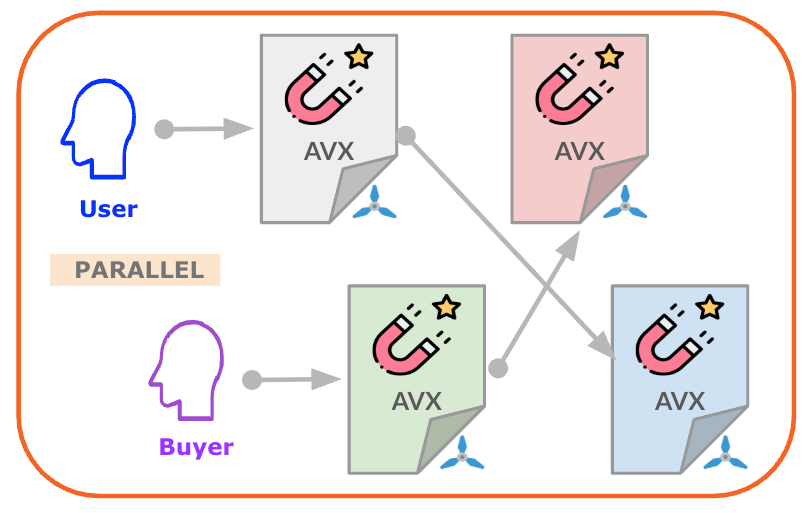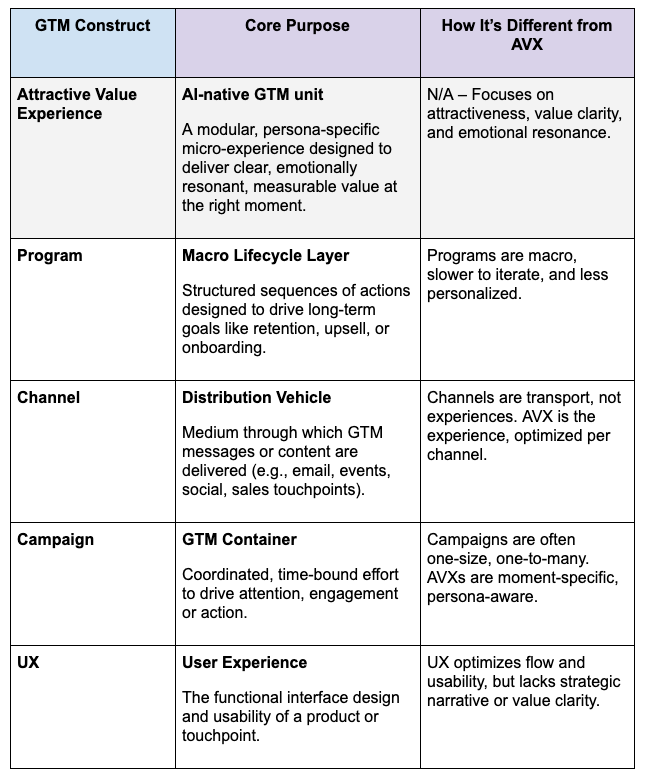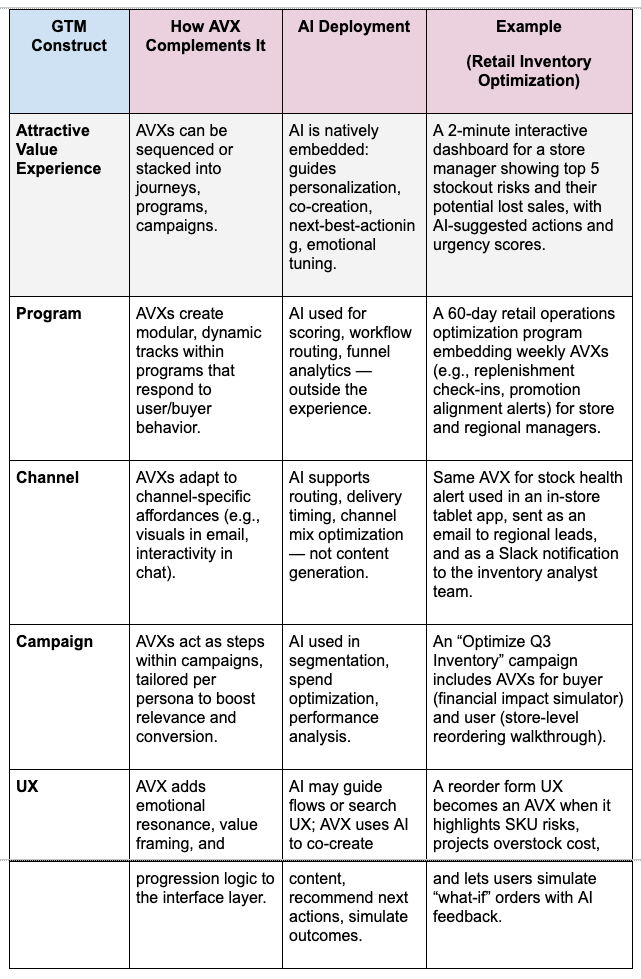An Attractive Value Experience (AVX): Framework for Building AI Native Go-to-Market Foundation
GTM should optimize for micro-experiences and AI-human collaboration - free worksheet inside!
This is a long post that introduces a new GTM framework: the Attractive Value Experience (AVX). It’s a practical, flexible unit designed for AI-native GTM teams who want to deliver value fast, with precision and accountability.
What’s inside:
Why classic GTM programs fail in AI-native environments
What is an Attractive Value Experience (AVX)
The 6 components of an AVX
How Human-AI Cognitive Pairing reshapes GTM execution
Real-world AVX journey examples, like AI inventory optimization
A free worksheet to help you design your first AVX today
This one’s for tech founders and builders who want their AI product to actually resonate with users and buyers. Let's dive in!
The landscape of enterprise software and AI is shifting rapidly, demanding a fundamental re-evaluation of how businesses go to market. Traditional GTM playbooks, while still relevant in parts, often fall short in harnessing the transformative power of Artificial Intelligence. For entrepreneurs building the next generation of AI-first or AI-enhanced solutions, a first-principles approach is not just an advantage—it's a necessity.
This post outlines a step-by-step framework to rethink your GTM strategy, anchored by the concept of the Attractive Value Experience (AVX) and with Human-AI Cognitive Pairing, powered by an ecosystem of AI agents.
How AI Disrupts GTM Campaigns
In today’s AI-driven GTM world, why are traditional campaign architectures still the default? Programs, campaigns, and tactics were designed for a pre-AI era—too bulky, too disconnected to keep up. AI is tossed into content, targeting, analytics—but where exactly should humans step in? Who owns the decisions? This lack of clarity creates friction, not flow.
Are we delivering value that truly resonates with buyers, or just amplifying noise? When AI speeds up execution but humans struggle to guide it, who’s accountable for meaningful outcomes? And how do we avoid wasting effort on fragmented campaigns that confuse rather than compel?
The root issue is simple but profound: the unit of GTM execution is outdated for human-AI collaboration.
Campaigns and programs are too large and vague, channels too siloed, and personas too generic to flex with real-time buyer needs—or to harness AI-human collaboration effectively.
So how do we rethink GTM for a world where AI isn’t just a tool but a partner? Where value is not an abstract goal but a tangible, micro-experience that aligns with buyer journeys and human judgment? The answer lies in a new, sharper GTM building block—one designed for continuous learning, intelligent pairing, and crystal-clear value delivery.
The Attractive Value Experience: A Foundational AI Native GTM Unit
The Attractive Value Experience (AVX) is a proposal for the foundational unit of GTM in the AI era—one that aligns with how buyers actually experience value and how teams can intelligently deliver it with AI and Agents. At its core, effective GTM is about consistently delivering value that compels customers forward. We define this foundational unit as an Attractive Value Experience (AVX).
AVX is a meticulously designed, measurable, and iterative micro-journey that attracts a customer with a small, self-contained value prop, engages them intelligently, and then propels them toward a specific immediate goal.
It's a holistic, single-purpose flow where interdependent components are strategically bundled to deliver clear-cut value, optimized for the right level of Human-AI Cognitive Pairing powered by a growing ecosystem of AI agents, and continuously refined.
In short:
AVX is a Micro Experience that
→ Attracts Customer with Value
→ Engages with Intelligence
→ Propels to a Goal
Six Components of an Attractive Value Experience
Every single AVX has six components that are necessary to make it functionally complete and effective as a GTM unit. Working in an integrated fashion, these six components deliver an experience that is self contained. Moreover, you can optimize these components based on feedback until the experience (and the underlying value prop) is strong enough to both attract and propel customers successfully to their goals.
Here are the six components and their roles:
AVX Examples
Zoom Webinar
AVXs often take the form of:
An AI-assisted interactive experience that delivers fast insight, outcomes or recommendations
A micro-journey that solves a high-value problem or risk for a specific persona
A proof-of-value tool or workflow that aligns to the buyer/user’s real-world decision-making or usage context
The unit of value in an AVX is intentionally small, clear, and specific to a target persona. It’s designed to be immediately useful, self-contained, and easily measurable — making it ideal for:
Accelerating user adoption and trust
Enabling champions with internal proof points
Driving usage-based expansion and upsell
The Power of Human-AI Cognitive Pairing in GTM
The true differentiator in AI-native GTM lies in the seamless Human-AI Cognitive Pairing. This isn't about AI replacing humans, but rather AI augmenting human capabilities and vice-versa, creating a synergistic GTM machine that is both scalable and deeply impactful. There are multiple levels of Human AI pairing feasible. Here is a basic one:
AI for Scale and Precision: AI excels at processing vast amounts of data, identifying patterns, personalizing content at scale, automating routine tasks, and providing predictive insights. This allows GTM teams to operate with unprecedented efficiency and precision.
Humans for Empathy and Strategy: Humans bring empathy, creativity, strategic thinking, complex problem-solving, and the ability to build deep relationships. In the GTM process, they interpret AI insights, craft compelling narratives, navigate complex negotiations, and provide the nuanced touch that AI cannot replicate.
Why This Matters for AI-Native GTM
Traditional SaaS go-to-market models — especially those built for large B2B products — are breaking down in the AI-native world:
AI-native products are faster, smaller, and more modular. They often deliver value in specific tasks or insights, not entire platforms.
Buyers and users expect proof of value early. They need to experience tangible value before full adoption or enterprise buy-in.
Human-AI pairing is central to usage. New forms of decision-making, productivity, and workflows are emerging — changing how GTM must prove value.
That’s why the AVX framework is key. It provides a repeatable way to design product-led, AI-native GTM that accelerates time-to-value, reduces friction in buying, and builds trust in intelligent systems.
Building GTM Pathways: Create and Orchestrate AVXs Across Customer Journey
Each AVX is built from three core parts to support customer journey:
Cognitive Pairing (Human + AI)
A clear mapping of how the AI augments, assists, or accelerates the customer (buyer, user or team) in achieving a specific goal or task.Context-Aware Unit of Value
A modular outcome, action, or insight that aligns to the customer’s real-world process, decision, or metric of success.Agentic Enablement to Attract & Propel
Designed to be demoed, shared, or used directly by the users and buyers to enable internal alignment, proof of value, and next-step adoption.
Together, these three elements form a durable architecture for a value journey that is:
Attractive (to the right persona)
Valuable (for their success metric)
Experiential (in the form of interaction, not just content)
A string of AVXs can be used to build custom GTM pathways.
Each attractive experience pulls a customer into a value cell, and upon delivery, triggers the next attractive experience. Ultimately, with right optimization of the GTM pathway itself (through AI) this approach helps customers discover the product offering, and reach their business outcome through its consumption.
In practice, this pairing manifests across GTM functions and applies to various personas, such as User and Buyer, across all stages of their Customer Journey.
End-to-End Example: Retail – Inventory Optimization
By meticulously designing and orchestrating multiple AVX experiences, you can build a GTM engine that is both efficient and deeply customer-centric, capable of leveraging the right AI's strengths at every turn.
Use Case: AI-powered inventory management and demand forecasting for omnichannel retail.
User Persona: Store Manager or Inventory Analyst
Buyer Persona: Head of Supply Chain or VP of Merchandising
User Journey – Store Manager / Inventory Analyst
Buyer Journey – VP of Merchandising / Head of Supply Chain
Note:
AVX Flexibility: AVXs are modular and persona-specific, yet linkable (e.g., usage data feeds business case).
Proximate Goal-Centric: Each AVX advances the journey with a specific, measurable goal.
Human-AI Pairing: AI and agents are embedded across both tracks—not just as backend automation but as a visible partner in delivery.
Five AVX Combination Customer Journey Patterns
No customer journey is linear. So, these AVXs can be combined in various patterns to craft and enable journeys to achieve customer goals.
Below is a summary of the five key ways AVXs can be used as building blocks in go-to-market (GTM) design—like Lego blocks or biological cells—followed by real-world-style examples for each pattern.
AVX as a Modular GTM Building Block
Pattern 1: Local Optimization [Lego brick]
What It Means: Each AVX can be optimized independently by refining its 6 elements based on performance.
Purpose: Nail individual moments of value
Example & Outcome: A customer onboarding checklist AVX for new admins. Use case: Focuses on helping an IT admin complete setup within 30 mins. Result: 30% faster time-to-value and 15% drop in setup-related support tickets.
Pattern 2: Sequenced Cascade [Relay Race]
What It Means: AVXs can be linked in a linear sequence along the journey to build momentum toward conversion.
Purpose: Drive engagement across time
Example & Outcome: A sequence from product trial → security validation → stakeholder approval. Use case: Orchestrates the buyer journey for an enterprise IT tool. Result: 2x faster deal cycles and smoother handoffs between sales and legal teams.
Pattern 3: Parallel Tracks [Threads]
What It Means: Different AVXs can run simultaneously for different segments, channels, or functions.
Purpose: Scale reach without confusion
Example & Outcome: Simultaneous AVXs for CFO (ROI modeling), VP Eng (integration demo), and Procurement (contract Q&A). Use case: Address different stakeholder needs concurrently in a complex sale. Result: 40% higher close rates due to role-specific value delivery.
Pattern 4: Stacked Personas [Big Moment]
What It Means: At one event or campaign, multiple AVXs can serve distinct personas (user, manager, exec).
Purpose: Drive dense engagement and conversion
Example & Outcome: Product pitch deck that combines AVXs for ROI, roadmap confidence, technical feasibility, and procurement clarity. Use case: Tailored pitch for CFO, CTO, and VP Ops in one enterprise meeting. Result: Stakeholder alignment in one session and accelerated decision.
Pattern 5: Channel Adaptation [Custom Fitting]
What It Means: Each AVX can be tailored to a specific GTM channel (e.g. email, live demo, outbound SDR).
Purpose: Maximize distribution efficiency
Example & Outcome: A self-assessment AVX on AI readiness delivered via email, LinkedIn, and partner webinars. Use case: One AVX deployed across three acquisition channels. Result: Increased lead capture volume by 3x without duplicating effort.
Note that AVXs are:
🔹 Modular: Can be deployed incrementally.
🔹 Composable: Can be arranged into sequences or stacked into bundles.
🔹 Contextual: Aligned to job-to-be-done (user) or business moment (buyer).
🔹 Adaptable: Works across touchpoints, lifecycle stages, and personas.
🔹 Trackable: Each AVX can be instrumented for engagement and conversion.
Therefore, AVX based AI native GTM approach can enable multiple GTM strategies: Product-Led Growth, Product Led Sales, Account Led Sales, Channel and Community Led Growth etc. How to ladder multiple AVXs into these strategies is outside the scope of this document, but an interesting area of work in progress.
Comparing AVX to Other GTM Constructs
Since AVX is a new AI-native GTM framework, it helps to understand how it differs from other common GTM constructs in favor today. It is critical to note that all current GTM units will remain relevant in the near future. Already, they are being used by every GTM practitioner to add and test AI capabilities with hundreds of tactics today.
Here is how AVX differs from current GTM constructs:
The AVX framework also complements these constructs and co-exists with each of them. Here is how:
Advantages of AVX: An AI Native GTM Framework
The Attractive Value Experience framework, especially when integrated with Human-AI Cognitive Pairing, offers significant advantages over conventional GTM approaches for AI products.
Enhanced Precision and Personalization: AI thrives on data and personalization. The AVX's focus on defining clear "Context" and "Proximate Goals" for each experience, combined with AI's ability to analyze customer data, allows for hyper-targeted messaging and interactions. This is far more effective than traditional broad-stroke campaigns, ensuring AI's value is demonstrated precisely where it matters.
Deep Customer-Centricity: By explicitly defining the "Value Proposition" and "Proximate Goal" from the customer's perspective in each experience, AVX ensures that every GTM activity is focused on delivering tangible customer value. This builds trust and adoption for AI solutions, which often require a shift in customer behavior.
Optimized Human-AI Synergy: The framework inherently promotes the best use of both human and AI capabilities. AI handles the heavy lifting of data processing and automation, freeing humans to focus on complex strategy, relationship building, and creative problem-solving – areas where AI currently falls short. This maximizes the impact of both, leading to more effective GTM.
Superior Efficiency and Scalability: By automating data analysis, content generation, and routine engagements (AI-Driven methods), and by augmenting human efforts (Human-AI Pairing), AVX enables GTM teams to achieve more with less. This scalability is crucial for AI companies aiming for rapid growth without linearly increasing human resources.
Real-time Optimization and Agility: The "Measure & Feedback" component is a core tenet of AVX. With AI, this feedback loop becomes real-time and highly granular. AI can rapidly process performance data, identify trends, and suggest optimizations for each experience, allowing for continuous, data-driven improvement that traditional, slower feedback cycles cannot match.
The Future of GTM is Built on Orchestrated AVXs with AI Agents
The era of AI demands a fundamental shift in GTM strategy. By embracing a first-principles approach centered on the Attractive Value Experience and strategically integrating Human-AI Cognitive Pairing powered by an evolving network of AI agents into every stage of the user and buyer journeys, entrepreneurs can unlock unprecedented growth.
This framework empowers you to design purposeful, measurable interactions that consistently propel your customers towards their goals, ensuring your AI innovations translate into undeniable market success. While demanding in its initial setup and requiring robust data infrastructure, the precision, scalability, and real-time optimization offered by the AVX framework make it the superior choice for navigating the complexities and opportunities of the AI-driven market.
Getting Started with AVX Approach
Initiate an AVX Pilot Program: Select a critical customer touchpoint and redesign it as a single Attractive Value Experience (AVX), meticulously defining its context, value proposition, engagement methods, proximate goal, measurement strategy, and investment level.
Form Cross-Functional AI-GTM Teams: Establish dedicated teams comprising GTM professionals and AI specialists to collaboratively identify opportunities for Human-AI Cognitive Pairing within your existing GTM programs, focusing on areas where AI can augment human precision and scale.
Conduct a "GTM Program to AVX" Audit: Review your current GTM programs and campaigns to identify how they can be broken down into modular AVXs, and then strategize how these AVXs can be sequenced, run in parallel, adapted for different channels, or stacked for diverse personas.
Assess AVX Technical Stack for Enablement: Pinpoint crucial gaps across your data, AI, delivery, measurement, and integration, giving you a clear roadmap for the technical effort needed. Don't let technical uncertainties slow your progress; leverage this assessment to build the precise capabilities for market success.
Develop an Internal Training Curriculum: Create educational materials and workshops to familiarize your entire GTM organization with the principles of the Attractive Value Experience (AVX) and the strategic implementation of Human-AI Cognitive Pairing, fostering a culture of AI-native GTM design.
If you enjoyed this post, consider subscribing to this free newsletter.
WORKSHEETS
Learn to use the ATX framework - get five FREE worksheets here:




